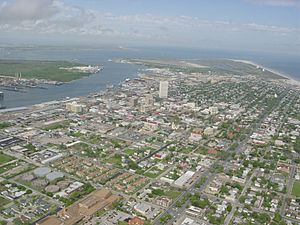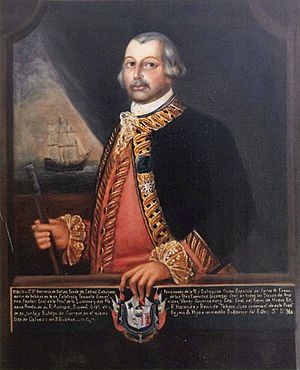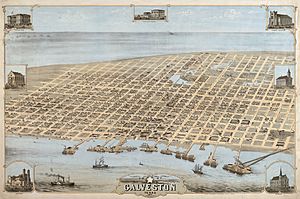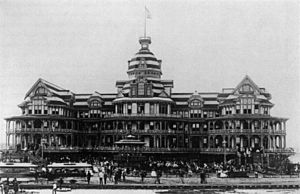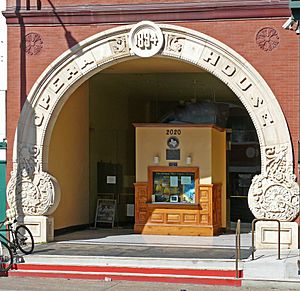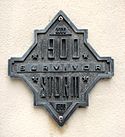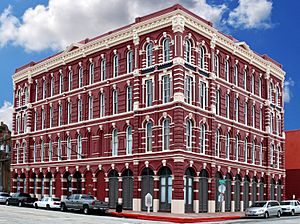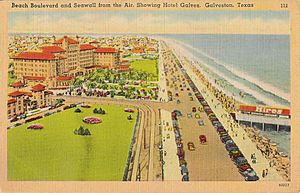History of Galveston, Texas facts for kids
The History of Galveston, Texas starts with the first people, Native Americans, who lived on the island. Europeans began building settlements on Galveston Island around 1816. The Port of Galveston was created in 1825 by the Mexican government after Mexico won its independence from Spain. During the Texas Revolution, Galveston was the main port for the Texas Navy. The city was founded in 1836 by Michel Branamour Menard, Samuel May Williams, and Thomas F. McKinney. For a short time, it even served as the capital of the Republic of Texas. During the American Civil War, the Battle of Galveston took place in Galveston Bay. Confederate forces, led by Major General John B. Magruder, attacked and pushed out the Union troops who were occupying the city.
In the mid-1800s, Galveston became an important international city. People and goods came from all over the U.S. and the world. It grew into one of the busiest ports in the country and the world's top port for shipping cotton. Galveston was Texas's largest city and its main business hub during this time. But in 1900, a terrible hurricane hit the island. This storm is still known as the deadliest natural disaster in U.S. history.
In the 1920s and 1930s, Galveston became a popular place for tourists, known for its lively entertainment. Places like the famous Balinese Room made the city famous along the Gulf. These entertainment spots eventually closed in the 1950s, which led to a long period where the city's economy didn't grow much. Many businesses left the island, but some, like insurance companies and the medical school, stayed.
Over time, Galveston slowly became a tourist spot again, focusing on its rich history and beautiful old buildings. New attractions were built, and the medical school continued to grow. These changes, along with other businesses, have helped the city's economy become strong again in recent years.
Contents
Early Exploration and Settlement
Galveston Island was first home to the Karankawa and Akokisa Native American tribes. They called the island "Auia." In 1519, the Alonso Álvarez de Pineda expedition sailed past Galveston Island. Spain claimed the entire Gulf Coast, including Galveston, based on this trip. Later, in November 1528, Álvar Núñez Cabeza de Vaca and his crew were shipwrecked on or near the island. They called it "Isla de Malhado" (which means "Isle of Doom"). From there, Cabeza de Vaca began his famous journey to Mexico.
Other Spanish explorers called the island "Isla Blanca" ("White Island") and later "Isla de Aranjuez" ("Aranjuez Island"). In 1685, French explorer La Salle named the island "San Louis" ("Saint Louis"), a name that stuck for a while.
The first known map of the island and bay was made by French explorer Bénard de La Harpe in 1721. He didn't name the island but called the bay "Port François." In 1785, Spanish explorer José de Evia mapped the Gulf Coast. He called the island "San Luis" and the bay "Bahía de Galveztowm" (Galveztowm Bay). This was to honor Bernardo de Gálvez y Madrid, Count of Gálvez. The name San Luis for the island was used by the Spanish and Mexicans for some time.
The first lasting European settlements on the island were built around 1816 by the pirate Louis-Michel Aury. He used it as a base to help Mexico's fight against Spain. In 1817, Aury returned to find the island taken over by another pirate, Jean Lafitte. Lafitte had moved there after being forced out of his base in Barataria Bay near New Orleans, Louisiana. Lafitte set up his own pirate "kingdom" called "Campeche" and called himself its "head of government." Lafitte stayed in Campeche until 1821. Then, the United States Navy told him to leave or be destroyed. Lafitte burned his settlement and sailed away secretly.
After Mexico won its revolution from Spain, the Mexican government officially created the Port of Galveston on October 17, 1825. In 1830, they built a customs house there. During the Texas Revolution, Galveston was the main port for the Texas Navy. It also became the capital of the Republic of Texas in 1836 when interim president David G. Burnet moved his government there.
In 1836, Michel Branamour Menard, from Canada, and his friends bought about 4,605 acres (18.6 km2) of land for $50,000 from the Austin Colony. They wanted to start the town that would become modern Galveston. The Texas government hired Robert C. Trimble and William Lindsey to survey this land, which they finished in 1837. Menard and his partners started selling land plots on April 20, 1838. In 1839, the City of Galveston got its official charter and was made a city by the Texas government. By this time, the name "San Luis" for the island was no longer used, and "Galveston" became its only name.
Galveston became an important city in the history of slavery in the U.S. In 1860, records show there were 1,178 enslaved people and two free Black people living in the city, compared to 6,000 free people. The disagreements over slavery across the U.S. eventually led to the American Civil War. Texas joined the Confederacy. The Battle of Galveston was fought on January 1, 1863. Confederate forces, led by Major General John B. Magruder, attacked and pushed out the Union troops from the city. Galveston stayed under Confederate control for the rest of the war. In May 1865, the CSS Lark successfully avoided the Union blockade off Galveston Harbor and sailed to Havana. It was the last Confederate ship to get through the blockade from any Southern port. In the late 1890s, the Fort Crockett defenses and coastal artillery were built in Galveston and along the Bolivar Roads.
Juneteenth is the oldest national celebration of the end of slavery in the United States. It started in Galveston when Union forces returned in 1865 and announced the Emancipation Proclamation. Galveston was also the first city in Texas to have a high school and a public library for African Americans.
Galveston's Golden Era
By the end of the 1800s, Galveston was a thriving city with 37,000 people. Its natural harbor on Galveston Bay along the Gulf of Mexico made it the main trading center in Texas. It was also one of the biggest cotton ports in the country, competing with New Orleans. Between 1838 and 1842, 18 newspapers started up to serve the fast-growing island population. (The Galveston County Daily News is the only one left today.) A causeway connecting the island to the mainland was finished in 1860, which helped railroads expand.
During this "golden era" of Galveston's history, the city had many "firsts" for Texas:
- The first post office (1836)
- The first naval base (1836)
- The first Texas chapter of a Masonic group (1840)
- The first cotton compress (1842)
- The first religious school (Ursuline Academy) (1847)
- The first insurance company (1854)
- The first gas lights (1856)
- The first Roman Catholic hospital (St. Mary's Hospital) (1866)
- The first Jewish Reform Congregation (Congregation B'nai Israel) (1868)
- The first opera house (1870)
- The first orphanage (1876)
- The first telephone (1878)
- The first electric lights (1883)
- The first medical college (now the University of Texas Medical Branch) (1891)
- The first school for nurses (1890)
Galveston was also home to the first Roman Catholic Cathedral in Texas. In 1839, Rome created the first Catholic leadership for Texas. Then, on May 4, 1847, Pope Pius IX approved the creation of the Diocese of Galveston. He named St. Mary's Church the Cathedral for the entire state of Texas.
In the mid-1800s, Galveston became an international city, even though it wasn't huge by world standards. People and trade came from all over the U.S. and the world. The island was sometimes called the "Ellis Island of the West" because it was the main entry point for European immigrants settling in the western United States. So many German immigrants arrived that the German language was often heard on the city's streets. These immigrants weren't just poor people seeking safety; many were educated, middle class individuals. The Galveston Weekly News reported that one ship in 1849 carried "wealthy class" members, including lawyers and merchants, and many skilled workers.
The late 1800s were a good time for civil rights for African Americans. After the Civil War, during Reconstruction, the power of former slaveholders in Texas was limited for a while. Leaders like George T. Ruby and Norris Wright Cuney worked hard to create education and job opportunities for Black people. They also helped organize Black voters to support the Republican Party, which was the main party supporting Black rights in the South at the time. Cuney's efforts led to better jobs and higher pay for Black people in the city, especially on the wharves. This eventually led to Black and white trade unions working together in the 1890s and early 1900s. Cuney himself became the chairman of the Republican Party of Texas, which was the most powerful position held by any Black American in the 1800s.
The Great Storm of 1900
In 1900, a terrible hurricane hit the island. Even after Hurricane Katrina, this storm is still the deadliest natural disaster in U.S. history. Early on September 8, high waves, even though the wind was blowing from the north, signaled the coming storm. By noon, low areas near the Gulf and the Bay side of the city were flooding, and the winds grew stronger. Around 4 p.m., a storm surge about 15 feet (4.6 m) high crashed into the coast. Wind speeds reached about 125 mph (201 km/h). This is an estimate because the wind measuring tool was blown off the U.S. Weather Bureau building. Isaac Cline was the chief weather forecaster there. A book called Isaac's Storm by Erik Larson tells the story of the hurricane based on his personal notes. The city was destroyed, and an estimated 6,000 to 12,000 people on the island died. After the storm, the city decided to build stronger defenses against future storms. They built a huge concrete seawall along a large part of the beach (from 1902–1904). The entire city's ground level was also raised about 17 feet (5.2 m) behind the wall and several feet near the Bay (from 1904–1910).
Rebuilding and the "Open Era"
Even with efforts to bring new businesses to the city after the hurricane, Galveston never fully returned to its earlier importance or wealth. Its growth was also slowed by the building of the Houston Ship Channel. This channel made the Port of Houston a direct competitor to Galveston's natural harbor for ship traffic. To help Galveston recover and grow its population, the city actively encouraged immigration. Through the work of Rabbi Henry Cohen and Congregation B'nai Israel, Galveston became the center of an immigration plan called the Galveston Movement. Between 1907 and 1914, this plan helped about 10,000 Eastern European Jewish immigrants avoid the crowded cities of the Northeastern United States. Many other immigrant groups, including Greeks, Italians, and Russian Jews, also came to the city during this time. This wave of immigration greatly changed the mix of people on the island, as well as in many other parts of Texas and the western U.S.
Even though the storm slowed economic growth and Houston grew into the main city of the region, Galveston did regain some of its past glory. People realized Galveston needed to do more than just port-related businesses. In 1905, William Lewis Moody, Jr., from one of Galveston's leading families, started the American National Insurance Company. Two years later, Mr. Moody invested more in Galveston by opening the City National Bank, which later became the Moody National Bank.
A military base for the US Army Coastal Artillery was set up on Galveston Island in the late 1890s. Construction was interrupted by the Galveston Hurricane of 1900 but finished in the early 1900s. The base was named Fort Crockett in 1903. During World War I, Fort Crockett was a training center for US Army artillery. Troops going to France learned how to use different types of artillery there. In the 1920s and early 1930s, Fort Crockett housed the United States Army Air Corps' (USAAC) 3rd Attack Group. This group was the only USAAC group focused only on attack aircraft. During World War II, the fort focused on defending against German U-boats and also served as a prisoner of war camp. After the war, Fort Crockett was an army recreation center for several years.
The Galveston–Houston Electric Railway was built in 1911 and ran between Galveston and Houston. This railway was known as the fastest interurban line in 1925 and 1926.
In the 1920s and 1930s, the city became a popular tourist spot again. The 1930s and 1940s brought many changes to the Island City. During World War II, the Galveston Municipal Airport, which later became Scholes International Airport, was made a U.S. Army Air Corps base and called "Galveston Army Air Field." The United States Army Corps of Engineers, using money from Congress, built three 6,000-foot (1,829 m) long, hard-surface runways at the airport for army aircraft. In January 1943, Galveston Army Air Field officially opened with the 46th Bombardment Group helping to fight submarines in the Gulf of Mexico. Later, it was replaced by the 10th anti-submarine squadron, flying RM-37 Lockheed Venturas.
In 1942, William Lewis Moody, Jr., and his wife Libbie Shearn Rice Moody, started the Moody Foundation. Its goal was to "benefit present and future generations of Texans." This foundation, one of the largest in the United States, would play a big role in Galveston in later years, helping to fund many community and health programs.
The end of the war greatly reduced military spending on the island. As the entertainment businesses declined, so did tourism, and the rest of Galveston's economy suffered. The city's economy and culture were never quite the same afterward. City leaders tried several new ideas that didn't work out, like the failed Oleander Bowl football tournament and the Pelican Island Bridge, which was meant to lead to a new industrial park that never happened. However, important non-entertainment businesses like insurance, banking, and the medical school helped keep the economy going.
Recent History
The island's economy went through a long period of slow growth. Many businesses moved off the island. By 1959, Houston had grown much larger than Galveston in population and economy. Because of this, Reverend Wendelin J. Nold, the fifth bishop of the Galveston Diocese, was allowed by the Vatican to set up a second Cathedral in Houston. He named Sacred Heart Church as a co-cathedral. The diocese was then renamed the Diocese of Galveston-Houston. Galveston and St. Mary's Cathedral Basilica still remained the main home of the diocese, but now the bishop could more easily reach the fast-growing Catholic population in Houston.
Starting in 1957, the Galveston Historical Foundation began working to save historic buildings. The 1966 book The Galveston That Was helped encourage this preservation movement. Restoration efforts, paid for by motivated investors, especially Houston businessman George P. Mitchell, slowly created the Strand Historic District and improved other areas. Over many years, a new type of family-friendly tourism grew in the city.
The 1960s saw more growth in higher education in Galveston. The city was already home to the University of Texas Medical Branch. In 1962, it got another boost with the creation of the Texas Maritime Academy, which later became Texas A&M University at Galveston. By 1967, a community college, Galveston College, was formed to provide affordable education to the community.
In the 2000s, property values went up after expensive projects were finished and more people wanted second homes. This caused some middle-class families to move from Galveston to other areas like League City, Texas City, and La Marque. The city's population stayed about the same from 2000 to 2005, according to the U.S. Census Bureau. In 2007, The Associated Press made a list of the places most at risk from hurricanes in the U.S., and Galveston was one of five areas named. Reasons included its low elevation and the single evacuation route off the island, which can be blocked by the fourth largest city in the United States, Houston.
Hurricane Ike hit Galveston Island early on September 13, 2008. It was a Category 2 hurricane with winds of 110 mph (177 km/h). Ike brought waves and a rising storm surge of about 14 feet (4.3 m). This water went around the famous Galveston Seawall, flooding the city through storm drains and the unprotected "bay side" of the island, even before the strong winds or rain started. The storm left Galveston without electricity, gas, water pressure, or basic communication. The Balinese Room, a historic nightclub that was on a 600-foot (183 m) pier extending into the Gulf of Mexico, was destroyed in the storm. The island has since gotten its services back, and people have returned, but some damage remains. Discussions are ongoing about building a large barrier called an Ike Dike to protect Galveston and the bay. As of 2009, this project was still being planned, and no money had been set aside for it.
Images for kids


